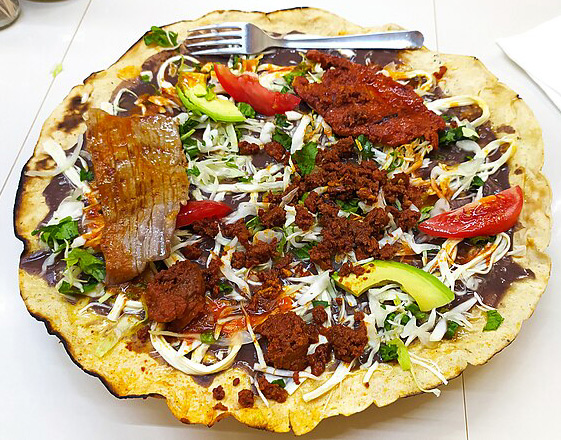OAXACA

CULINARY THUMBNAIL
Here are the most notable characteristics of this state's cuisine:
- strong influence of indigenous cultures
- seashore, tropical lowland and cool upland environments provide a huge diversity of produce
TRADITIONAL DISHES TO LOOK FOR
 Tlayuda con tasajo y chorizo, which is a large, thin, crunchy, partially fried or toasted tortilla covered with a spread of refried beans, asiento (unrefined pork lard), lettuce or cabbage, avocado, meat (usually shredded chicken, beef tenderloin or pork), Oaxaca cheese, and salsa; copyright-free image made in a restaurant in Oaxaca, courtesy of "WeltKonnte," made available through Wikimedia Commons.
Tlayuda con tasajo y chorizo, which is a large, thin, crunchy, partially fried or toasted tortilla covered with a spread of refried beans, asiento (unrefined pork lard), lettuce or cabbage, avocado, meat (usually shredded chicken, beef tenderloin or pork), Oaxaca cheese, and salsa; copyright-free image made in a restaurant in Oaxaca, courtesy of "WeltKonnte," made available through Wikimedia Commons.- Cocido -- stew usually including beef, pork, chicken, garbanzos, string beans, chayote and other small squash, cabbage, carrots, "guineo" bananas, seasoned with cilantro and hierbabuena herb, accompanied by rice and chili sauce
- Mole Negro -- the most famous of many moles, this "black mole" is made with turkey
- Chiles Rellenos de Sardinas (on the coast) -- chilies stuffed with small fish
- Tortillas Clayudas (or "Tlayudas") (in the central valleys) -- large, thick, leathery tortillas
- Totopos -- very large, perforated, toasted tortillas
SWEETS
- Alegría -- toasted, popped and sweetened amaranth seeds
- Ate -- candied fruit; often ate is used as a suffix on a fruit's name, so that a mangate is a mango ate, and a guayabate is a guava ate
- Capirotada -- especially during Lent, a white-bread pudding with various combinations of ingredients, such as cheese, tomato, peanuts, raisins, and biznaga cactus, all covered with syrup
- Gaznate -- cylindrical sweet filled with meringue
- Mamón -- a bland, spongy bread of corn starch, egg, sugar, and cinnamon
NON-ALCOHOLIC DRINKS
- Pozol de Cacao -- pozol is made by grinding boiled corn kernels to form the moist paste called masa, stirring the masa into water, and adding a pinch of salt or sugar; this one has ground cacao (chocolate) added
- Tejata -- made from toasted and ground cacao and seeds of the mamey fruit with a certain kind of small flower.
Information on this page based on material presented in Gastronomía: Atlas cultural de México, 1988, an extensive and well illustrated work by various authors, published by the Secretaría del Educación Pública, Instituto Nacional de Antropología e Historia in Mexico City.